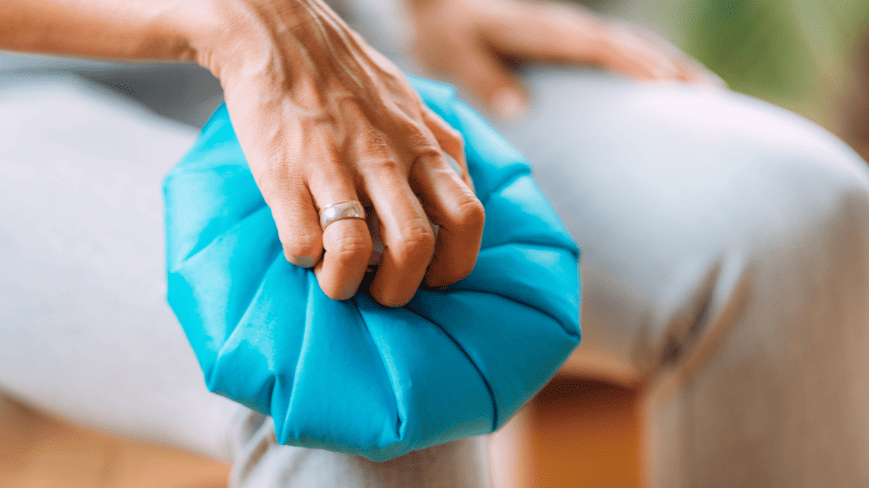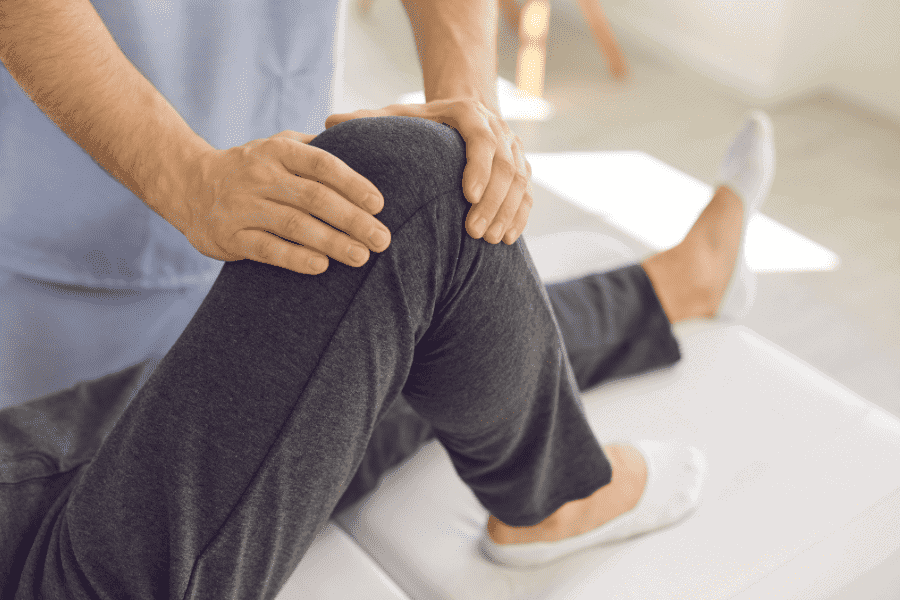How to Alleviate and Manage Knee Pain

- Why am I Having Knee Pain?
- What are Common Causes of Knee Pain?
- How can Knee Pain be Managed at Home?
- What are the Treatment Options for Knee Pain?
If you’re living with knee pain, you know how difficult some activities can be. Over 25% of adults report persistent knee issues at some point, causing disruptions in their daily activities and mobility.
To understand what causes knee pain and treatment, here are some insights on why this pain is so persistent and ways to manage your pain. However, other options exist to reduce or eliminate knee pain if you need more advanced treatment.
Why am I Having Knee Pain?
Knee pain may not always indicate the precise source because it can radiate from one location to another, a condition known as referred pain. The pain could manifest around the joint – at the front, back, or side.
Symptoms
It is important to consider the type of pain, whether dull and persistent or sharp and piercing. Providing in-depth details to your doctor can help them better evaluate the pain and understand the symptoms, ensuring more effective treatment. A variety of symptoms may appear, including:
- Pain: ranges from dull aches to sudden stabbing sensations.
- Swelling: noticeable swelling around the knee joint.
- Stiffness: difficulty bending or moving the knee without pain.
- Instability: feeling like the knee might give out or bearing weight becomes challenging.
- Limited range of motion: inability to fully extend or flex the knee.
- Warmth or redness: warmth or redness in the knee area.
- Audible sound: popping, grinding, or grating sensations in the joint.
Contributing Risk Factors to Knee Pain
- Weight: Excess weight strains knee joints, increasing wear and tear, especially in osteoarthritis.
- Aging and degenerative changes: Cartilage wears down naturally with age, contributing to conditions like osteoarthritis.
- Repetitive activities: Activities involving repetitive motions stress the knees, causing overuse injuries.
- Muscle weakness or imbalances: Weak or imbalanced muscles around the knee impact joint stability.
- Improper footwear or training technique: Inappropriate footwear or techniques increase knee stress, leading to pain.
What are Common Causes of Knee Pain?

Structural or Mechanical Factors
This type of pain stems from injuries to various knee components, which may involve:
- Ligament tears, like the anterior cruciate ligament (ACL) tears
- Meniscus tears
- Cartilage damage
- Dislocation
- Presence of a loose body (a bone or cartilage fragment floating within the joint, hindering proper joint function or causing irritation)
- Patellar misalignment occurs when the kneecap is displaced from its normal position (Occasionally influenced by hip or foot discomfort that alters walking mechanics.)
Joint or Inflammatory Disorders
Inflammatory or rheumatic ailments encompass specific medical conditions that trigger inflammation and discomfort in the knee’s soft tissues. These conditions comprise:
- Osteoarthritis
- Tendinitis, such as patellar tendinitis or iliotibial (IT) band syndrome
- Bursitis, characterized by inflammation of the bursae
- Arthritis and rheumatoid arthritis
- Gout is arthritis that induces abrupt, intense pain and swelling in the joint.
- Reactive arthritis entails joint pain and swelling instigated by an infection originating elsewhere in the body.
Overuse or Repetitive Strain Injuries Causes
Repeatedly performing the same motions can strain bones, joints, and muscles. Such repetitive movements could be associated with your occupation, workout routine, or your body’s natural mechanics. These repetitive actions may lead to injuries like stress fractures, which are minute cracks in the bone, or conditions like runner’s knee.
The term “runner’s knee” is commonly used because it frequently occurs in individuals engaged in running or sports involving frequent running and jumping.
Traumatic or Acute Injuries Causes
Additional injuries resulting in knee pain include:
- Fractures involving the breaking or cracking of knee bones
- Ligament sprains or ruptures are characterized by the tearing or stretching of connective tissue beyond its limit
- Dislocation is a condition where the kneecap is displaced from its normal position
- Contusions, signifying bruises occurring on the bone
Other Causes
Septic arthritis occurs when infectious agents like bacteria, fungi, or viruses infiltrate the joint fluid and surrounding tissues. This condition can cause severe inflammation and discomfort in the affected area. Additionally, systemic chronic illnesses such as lupus and fibromyalgia can contribute to experiencing knee joint pain.
How can Knee Pain be Managed at Home?
Using home remedies can improve comfort and help with symptom management. However, if pain persists, worsens, or becomes moderate to severe, seeking medical care for a comprehensive evaluation is advisable.

For strains or sprains, applying the RICE method can offer relief:
- Rest: Cease the activity causing pain, if possible.
- Ice: Apply a wrapped ice pack or use frozen vegetables (like peas) wrapped in a towel on the affected knee.
- Compression: Use a compression bandage around the knee to minimize swelling, ensuring it’s not overly tight to allow proper circulation.
- Elevation: Keep the leg elevated while resting to assist in reducing swelling.
Alternating between cold and heat therapy can also alleviate discomfort:
- Apply heat for up to 20 minutes at a time.
- In the initial two days following an injury, use cold packs for 20 minutes, repeating four to eight times daily.
- Prevent direct contact between ice and skin by using a towel or cloth.
- Before applying heat, ensure the pad’s temperature is manageable.
- Avoid heat therapy if the joint is warm or swollen during a flare-up.
- A warm bath or shower in the morning might help alleviate stiffness.
Over-the-counter medications like nonsteroidal anti-inflammatories (NSAIDs) can also help alleviate pain.
What are the Treatment Options for Knee Pain?
Once your doctor has provided a diagnosis, you’ll better understand the available treatment options for knee pain, which generally fall into two categories: nonsurgical and surgical. Typically, many individuals opt for nonsurgical treatments initially, seeking to avoid surgery. Your healthcare team will guide and assist you in making these decisions.

Nonsurgical treatments for knee pain include:
- Medications such as nonsteroidal anti-inflammatory drugs (NSAIDs) to alleviate pain and inflammation
- Physical therapy aimed at strengthening knee muscles and enhancing range of motion
- Injections like corticosteroids
- Assistive devices, such as knee braces or orthotics, to enhance stability and relieve pressure on the knee joint
Surgical treatments are considered when the joint sustains severe damage or after exhausting other treatment avenues. Surgical options include:
- Arthroscopy is a minimally invasive procedure that can be used for diagnosis and surgery. It involves inserting a small camera into the knee, enabling precise actions such as trimming damaged cartilage, clearing debris, and reconstructing ligaments, like repairing a torn ACL.
- Osteotomy is typically performed to address joint damage from arthritis by realigning the knee. This involves cutting the top of the shinbone or the bottom of the thighbone and reshaping it to shift weight away from the knee.
- Partial knee replacement involves removing and replacing either the inside or outside part of the knee joint with artificial components.
- Total knee replacement is when the surgeon replaces both the femur’s and tibia’s ends with metal and plastic components. Sometimes, a plastic button may be placed on the back of the kneecap to replace worn-out cartilage.
Should You Get Treatment for Knee Pain?
Don’t let knee pain limit your daily activities. If you have questions or think it’s time to visit Orlando Orthopaedics Center for personalized treatments, make an appointment today or visit one of our locations throughout Orlando.


